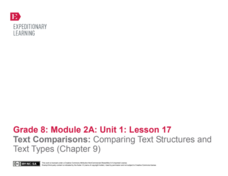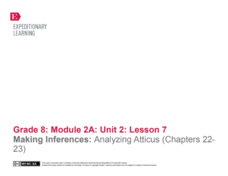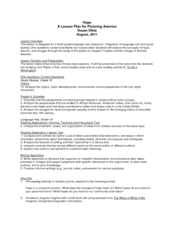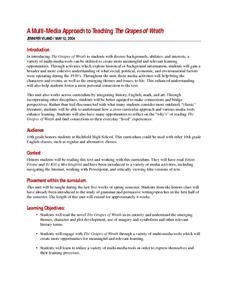My Access
“Banning Books” Lesson Plan
To Kill a Mockingbird, Hunger Games, Brave New World. Welcome to Banned Books Week. As part of a study of censorship and book banning, class members investigate censorship, the purposes of censorship, and First Amendment rights,...
PBS
The History of Book Banning in America
Harry Potter, Are You There God? It's Me, Margaret, To Kill a Mockingbird. Kids view a slide show and then discuss the seven banned books featured in the presentation and the reasons why the books may have been banned.
EngageNY
Text Comparisons: Comparing Text Structures and Text Types (Chapter 9)
Scholars revisit the comparisons they made in the previous lesson of "Incident" and To Kill A Mockingbird. They talk with their discussion appointment partners about the structure of a narrative and use a Compare and Contrast Note...
EngageNY
Analyzing Word Choice: Atticus’s Closing Speech (Chapters 20-21)
Choose your words carefully. Scholars begin by reading a line of Atticus's closing speech in To Kill A Mockingbird. Readers work independently on their note catchers, then complete a Think-Pair-Share activity with partners. They finish...
EngageNY
Close Reading: Focusing on Taking a Stand (Chapter 2 cont.)
Scholars complete a close read of To Kill a Mockingbird and determine why characters take a stand. They use text-dependent questions and Note-catchers to help guide their thinking. Readers review the Taking a Stand Anchor chart and...
EngageNY
Analyzing How Literature Draws on Themes from the Bible and World Religions: The Golden rule (Chapter 3)
Scholars use their Golden Rule Note-catcher to examine passages from To Kill a Mockingbird. They then take a gallery walk to compare and contrast the quotes before sharing Think-Write-Pair-Share ideas on how the quotes demonstrate the...
EngageNY
Making Inferences: Analyzing Atticus (Chapters 22- 23)
What's the verdict? Scholars look closely at the reactions of various characters in To Kill A Mockingbird in the aftermath of the verdict. They circulate the room, responding to a variety of probing questions. Pupils finalize their...
EngageNY
Close Reading: Fishbowl Comparing Atticus and Mr. Gilmer (Chapters 17-19)
Class members participate in two circle group discussions to compare Atticus and Mr. Gilmer in chapters 17-19 of To Kill a Mockingbird. They use a note-catcher to guide their thinking. For homework, readers begin looking at chapters 20-21.
EngageNY
Mid-Unit Assessment: Readers Theater Scene Selection Justification and Peer Critique
Is it justified? Readers complete the mid-unit assessment to justify their reader's theater scenes and quote choices from To Kill A Mockingbird. After completing the assessment, scholars conduct peer reviews and critique the script...
EngageNY
End of Unit 3 Assessment: Readers Theater Commentary
Prove it! In the end-of-unit assessment, scholars write a commentary and provide evidence to justify the connection between their reader's theater scripts and To Kill A Mockingbird. After completing the assessment, they practice...
Reed Novel Studies
Paperboy: Novel Study
Little Man, in Vince Vawter's Paperboy, is a great baseball player, but due to stuttering he'd rather not speak to a soul. Scholars read how Little Man deals with his fears as they use vocabulary words to complete sentences, answer seven...
Curated OER
To Kill a Mockingbird
Students participate in a layered curriculum unit in order to give them opportunities to master objectives. Students pick the activities and this allows a differentiated lesson to occur with many opportunities for assessment.
EngageNY
Writing and Argument Essay: Peer Critique with Rubric (Chapters 29-31, Including Synthesis of Scenes in Previous Chapters)
Hungry? Try a quote sandwich! Writers discover the concept of using a quote sandwich to introduce and analyze a quote in an argumentative essay properly. Additionally, pupils engage in peer critiques, analyzing each other's drafts and...
EngageNY
Performance Task: Readers Theater Performance
It's show time! Scholars finalize their learning by performing their Reader's Theater script of To Kill A Mockingbird. As groups of actors perform, the remaining pupils give feedback using a rubric. After all groups finish, each person...
EngageNY
Writing an Argument Essay: Evaluating the Model and Crafting a Claim (Chapter 28, Including Synthesis of Scenes in Previous Chapters)
Scholars use the model essay from the previous instructional activity to create their own argumentative essays. Readers make a claim about Atticus defending Tom in To Kill A Mockingbird. They then use graphic organizers to develop and...
Curated OER
Picturing America: Images and Words of Hope from Romare Bearden and Langston Hughes
A carefully crafted three-day instructional activity integrates poetry and visual art. By analyzing and comparing Langston Hughes' poem "Mother and Son" and Romare Bearden's collage "The Dove," readers explore the theme of hope. The...
Curated OER
Revision Activities
In this revision activities worksheet, students plot the development of tension throughout the book, answer seven questions about plot, analyze characters and theme, and discuss the writing style of the author. Students answer ten short...
Curated OER
My Ideal World
Learners create an image symbolic of their ideal world. In this lesson inspired by To Kill a Mockingbird and the artwork of Edward Hicks, students use Adobe Photoshop to create an image symbolic of their personal utopia.
Perfection Learning
I Know Why the Caged Bird Sings
A revolutionary work of literature requires a revolutionary assessment project. A series of activities on Maya Angelou's I Know Why the Caged Bird Sings includes discussion questions, a plot synopsis, and a selection of both short and...
Curated OER
A Multi-Media Approach to Teaching The Grapes of Wrath
Integrate history, math, and art into a study of The Grapes of Wrath with a series of activities that ask learners to investigate the social, political, economic, and environmental factors at play during the 1930s. Designed to be used...
Curated OER
Exploring Prejudice and Text-to-Text Relationships
Tenth graders use the novel To Kill a Mockingbird to analyze relationships in society. In this literature analysis lesson, 10th graders participate in a shoe activity where they bring in one shoe belonging to someone they know and a...
Curated OER
Famous Authors Biographical Data Form
Who wrote To Kill a Mockingbird? What about Wuthering Heights? Prodigal Summer? Encourage learners to study the authors of their beloved books. This form will help them organize information as they learn about different authors. After...
Curated OER
Design for Social Justice
Students create a solution to a social justice problem within their community. In this urban planning lesson, students read To Kill a Mockingbird by Harper Lee and A Lesson Before Dying by Ernest Gaines. Students then complete a research...
Curated OER
Literature: Mapping the Mockingbird
Students read Harper Lee's To Kill a Mockingbird, focusing on setting. They list items that create mental images of the novel's setting along with location references to characters and events. Using posterboard, they construct physical...
Other popular searches
- To Kill a Mockingbird Unit
- To Kill a Mockingbird Test
- To Kill a Mockingbird Movie
- To Kill a Mockingbird Quizzes
- Reading to Kill a Mockingbird
- To Kill a Mockingbird Essay
- To Kill a Mockingbird Trial
- For to Kill a Mockingbird
- Compare to Kill Mockingbird

























